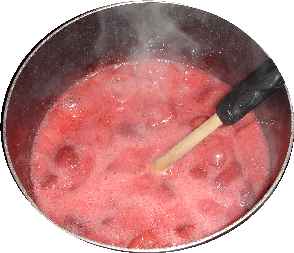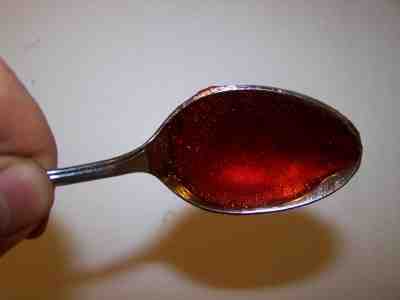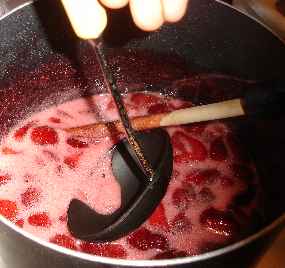
Looking for How to Fix (or Remake) Jam or Jelly That Turns Out Too Soft or Runny in 2025? Scroll down this page and follow the links. And if you bring home some fruit or vegetables and want to can, freeze, make jam, salsa or pickles, see this page for simple, reliable, illustrated canning, freezing or preserving directions. There are plenty of other related resources, click on the resources dropdown above. If you are having a hard time finding canning lids, I've used these, and they're a great price & ship in 2 days.
If you have questions or feedback, please let me know! There are affiliate links on this page. Read our disclosure policy to learn more.
How to Fix (or Remake) Jam or Jelly That Turns Out Too Soft or Runny
Sometimes after you have canned your jam, jelly or other preserves and let it cool, you open a jar, only to find it hasn't set properly an d is too runny! If your jam or jelly turns out too soft or runny, don't despair, and don't throw it away! It can be fixed! Here's how!
If the jam is too thick, before you put it in the jars, just heat 1 or 2 cups of grape juice (or any other fruit juice of similar or neutral taste, like apple or white grape) to boiling. Then, gradually pour and stir it in until you reach the desired consistency, then continue canning!
If the jars are already sealed / canned, then when you use them, just stir in a little grape juice until you reach the desired thickness.
If the jam turns out too runny, that is a little different to fix. Here's how:
Or click here for a PDF version that prints nicely! If you want this page in metric units, click here! And Google has a great conversion calculator that will convert from any units to any units.
Ingredients
- The jars of jam to be remade
- No-sugar-needed type pectin - available at most grocery stores and big box stores and online here, at right. If you use regular pectin, that may make the jam or jelly too sweet! 1 box of dry pectin is equal to 1.75 oz (by weight, or 7 tablespoons, or almost 1/2 cup or 21 teaspoons).
- Lemon juice
- Sugar
Supplies
- New lids for the jars (you can reuse the rings and wash the jars.)
Background
It takes 3 ingredients for jams and jellies to set: pectin, sugar and acidity. The amount of pectin that is naturally occurring in the fruit varies from one type of fruit to another and by ripeness (counter intuitively, unripe contains more pectin). See this page for more about pectin in fruit. It takes the right balance, and sufficient amounts of each of pectin, sugar and acidity to result in a firm jam or jelly.
And beyond the balance of those ingredients, there are two conditions that must be met: the right amount of heat for the right amount of time. It takes a brief period (1 minute) of a hard boil, to provide enough heat to bring the three together. Generally speaking, if your jam doesn't firm up, you were short in pectin, sugar or acidity or didn't get a hard boil. We will correct that when we remake the jam or jelly!
Finally, you CANNOT reliably make batches of jam larger than 6 cups of raw fruit (of course, but the time you add sweetener, lemon juice, etc. it will be more than that). No matter how much you stir, you won't get effective heat penetration in larger batches, so some pectin gets overcooked, while other pectin is not activated. So, to reliably fix the jam, you will need to split it into batches of less than 7 cups each.
Step 1 - Empty the jars into a pot and clean the jars
Empty the jars that are to be remade into a large pot (I like 16 qt)
Then clean the jars and discard the used lids. Your jars need to be clean and "sterile" - Sterile means put them into the boiling water bath when you fill the canner and then remove them right before you fill them. That way the will be hot and sanitized. The lids should be kept in hot, steamy (but not boiling) water (around 180 to 200 F, or 80 - 90 C)

 Step
2 -Determine how much jam or jelly needs to be remade
Step
2 -Determine how much jam or jelly needs to be remade
Measure the jam or jelly to be recooked. Work with no more than 4 to 6 cups
at a time. Check all the jars from the batch - if one failed to set, most or all
probably failed. You can check by just turning them upside down and seeing
how quickly the jam or jelly shlooshes* around in the jar.
(* - Schloosh - from the old Pennsylvania Dutch verb, "schlushen" meaning to flop around like a
freshly caught trout)
Add up the volumes of all the jars to be reworked, to figure out the size of the batch (in quarts) for step 2.
1 qt = 32 oz = 2 pints = four 8oz jars = eight 4oz jars).
Open the jars to be fixed and dump them all into a large pot.
Since you will probably want to reuse the jars, get the now emptied jars washing in the dishwasher.
Step 3 - Measure out additional pectin, water, sugar and lemon juice
If you are using powdered pectin:
For each quart of jam or jelly to be fixed, mix 1/4 cup sugar, 1/4 cup water or white grape juice, 2 tablespoons bottled lemon juice, and 4 teaspoons powdered pectin in a large pot. So, if you made a batch of jam and have 10 eight-ounce jars that didn't set, that would be an average batch (10 cups or 2.5 quarts). For that average batch of about 2.5 quarts total, you would need 2/3 cups sugar, 2/3 cups water or juice and about 1/3 cup lemon juice, plus about 3/4 of a box of pectin, preferably the no-sugar variety.
This table may help you with calculations:
| Amount of jam or jelly to re-make |
sugar | water or grape juice |
lemon juice | pectin |
| 2 cups (1pint) | 4 teaspoons | 4 teaspoons | 1 tablespoon | 2 teaspoons |
| 3 cups | 6 teaspoons | 6 teaspoons | 1.5 tablespoons | 3 teaspoons |
| 4 cups (1 quart) | 1/4 cup | 1/4 cup | 2 tablespoons | 4 teaspoons |
| 5 cups | 1/4 cup | 1/4 cup | 2.5 tablespoons | 5 teaspoons |
| 6 cups (1.5 quarts) | 1/3 cup | 1/3 cup | 3 tablespoons | 6 teaspoons |
| 7 cups | 1/3 cup | 1/3 cup | 3.5 tablespoons | 7 teaspoons |
| 8 cups (2 quarts) | 1/2 cup | 1/2 cup | 4 tablespoons | 8 teaspoons |
Remember, if you have more than 6 cups of jam,
If you are using liquid pectin:
For each quart of jam or jelly, measure 3/4 cup sugar, 2 tablespoons bottled lemon
juice, and 2 tablespoons liquid pectin in a large pot.

Step 4 - Mix with the jam or jelly and bring to a boil
Add the jam or jelly to the pectin mixture and bring it to a rolling boil, over high heat, stirring constantly. Keep in mind that one reason jams and jellies don't set is because people try to double batches, and there is non-uniform heating. That results in some pectin becoming over-cooked and some pectin in the batch is under cooked. Never make a new batch of jam or jelly starting with more than 6 cups of crushed fresh or frozen fruit; and never try to remake a batch larger than 2.5 quarts.
Once it is a rolling boil, then boil it hard for 45 to 60 seconds (1 minute). A "hard boil" is distinctly different from a "rolling boil". A rolling boil is simply the production of bubbles but is not all-encompassing and may even be stirred down.
A hard boil often produces foam and the jam expands, rises to fill more of the pot, and cannot be stirred away
Don't "overboil" Just 1 minute of a "hard boil"
Step 5 - Testing for "gel" (thickness)
 I
keep a metal tablespoon sitting in a glass of ice water, take it out, shake off
the water and then take a half
spoonful of the mix and let it cool to room temperature on the spoon. in a
minute or so. If it
thickens up to the consistency I like, then I know the jam is ready. If not, I
mix in a little more pectin (about 1/4 to 1/2 of another package) and bring it
to a boil again for 1 minute.
I
keep a metal tablespoon sitting in a glass of ice water, take it out, shake off
the water and then take a half
spoonful of the mix and let it cool to room temperature on the spoon. in a
minute or so. If it
thickens up to the consistency I like, then I know the jam is ready. If not, I
mix in a little more pectin (about 1/4 to 1/2 of another package) and bring it
to a boil again for 1 minute.
Step 6 - Remove, from heat, skim and fill the jars
Remove from heat, and quickly skim the foam off jam or jelly.
Fill sterile jars (automatic dishwashers often have a sanitize setting, otherwise, wash and dry and add 5 minutes to the processing time), leaving 1/4-inch headspace. Adjust new lids (don't reuse the previous lids, they are single use) and...
Step 7 - Process in the water bath
... process as recommended in the table below.
| Recommended process time for Remade Soft Jellies in a boiling-water canner. | |||
| Process Time at Altitudes of | |||
| Jar Size* | 0 - 1,000 ft | 1,001 - 6,000 ft | Above 6,000 ft |
| Half-pints or pints | 5 min | 10 | 15 |
*Larger sizes are generally not recommended for jams and jellies
Lessons learned
- If the jam was too runny, then next time you might want to add about 20% more pectin to start with, or make sure you bring to a full hard boil for 1 minute (not less, and not more than a few seconds longer).
- If it was too thick, add a little less pectin, and/or a bit of fruit juice before you cook it!
- Limit your batch sizes to no more than 6 to 8 cups of crushed fruit to start - meaning each batch should produce no more than 8 to 11 jars (8 oz each) of jam or jelly.
If you want to learn more about pectin, how it works and the different types of pectin, and where to get it; see this page.
Can I use Instant freezer pectin to make cooked / canned jams and jellies?
See this page for the answer!
Feedback
- Comments from a visitor on September 15, 2017: "Thank you so much for the jam repair recipe, especially for liquid pectin since that is what I used. Worked perfectly.. Also I boiled it hard like you said and wow it is stiffer now Great flavor no corn syrup since I made it my self Just glad I did not have to throw it out Blessings to you and yours Happy Alaskan
- Comments from a visitor on July 18, 2016: "Hello, I just wanted to thank you for the information on "fixing" my runny jam. I have been an avid home cook my entire life - even had a catering business in the 1980's. After several (large) batches of very runny - liquid - jam - I was ready to throw them out the window! I will try your helpful suggestions and re-make my 19 jars of blackberry jam with fingers crossed. I did not use pectin, following the recipe that was the problem! My husband keeps a farm diary on his Facebook page at Bramley Farm LLC. Thank you again for your great information! Sincerely, Pam"
- Comments from a visitor on July 13, 2016: "Thank you. You saved my strawberry jam from becoming sauce!"
- Comments from a visitor on August 03, 2014: "The recipe for remaking worked great. Now we can officially enter it into the fair. It was a lot of work making jelly and I (like many others on your awesome website) did not want to waste the fruit. Thanks so much"
- Comments from a visitor on July 11, 2014: "THANK YOU!! Your website and directions for how to fix runny jam SAVED me and my Strawberry jam yesterday! Originally from PA and with German heritage, my jam was definitely "schlooshing" around. I remade 8 cups (yes too much -berries very ripe) to your instructions and with a little extra pectin and we're all good! Thank you for this site and what you do here! Very helpful... Lisa M."
- Comments from a visitor on November 03, 2013: "Thanks for your page on redoing jelly that doesn't set the first time. It saved a batch of apple jelly I had made previously. Your website is a wonderful resource for canning, especially if you are just starting out. The directions are clear and easy to understand. Thank you again for all the work!"
- Comments from a visitor on October 20, 2013: "I am new to canning so it was no surprise that I messed up my a batch of pomegranate pear jam. I knew it was too runny when I put it into the jars but I wasn't sure what i had done wrong. I found your blog and recooked the jam as you instructed and, voila!, to my great surprise and joy, my jam is now thick and gorgeous. Just thought you'd enjoy knowing you saved my jam from the bin. Thank you soooo much. "
- Comments from a visitor on September 29, 2013: "Thanks so much for your tips on how to fix runny jelly. Mom and I made some Rootbeer jelly and it didn't set up but with your tips on how to fix the jelly it saved the day! Thanks so much mom and I have used your site a lot for tips and how to's on canning."
- Comments from a visitor on September 18, 2013: "My husband and I picked a bunch of beach plums this month, and rendered several quarts of juice. My usually reliable recipe for jelly failed, and I was horrified! If you have ever made beach plum jelly, you know that it's more precious than gold! I was so thankful to come across your instructions for remaking failed jelly - it worked beautifully! Not only that, but this website is AWESOME!! Thank you so much! I've sent the page to my daughter and all of my friends who can and preserve."
- Comments from a visitor on July 17, 2013: "Made strawberry jam and it did not set properly. Followed your directions to fix unset jam and worked like a charm!! Thank you for saving my jam :)"
- Comments from a visitor on November 05, 2010: "Your "How To Fix Runny Jam" worked great for me too. I made the "Grapefruit Marmalade" from the "Ball Blue Book of Preserving", but it didn't set at all. Marmalade is not usually as set as jam, but it's not liquid, which mine was. I reprocessed using your instructions and it worked perfectly, for a 16-cup batch no less. "
- Comments from a visitor on July 17, 2010: "Thank you for your method to fix runny jam. I used it on my kumquat jam and it worked beautifully. My three little kumquat trees bear lots of fruit and I make jam every year with more or less success. This year it is the best ever - I have never made such beautifully set jam. Wish you could taste it too. Kind Regards, Claire"
Illustrated Canning, Freezing, Jam Instructions and Recipes
[ Easy Home Canning Directions] [FAQs - Answers to common questions and problems] [Recommended books about home canning, jam making, drying and preserving!] [Free canning publications to download and print]
Looking for canning equipment and supplies?
Water bath canner with a jar rack
Pressure canners for gas, electric and induction stoves: Presto 23Qt or T-fal 22Qt
Canning scoop (this one is PERFECT)
Ball Blue book (most recent version)
Jars: 8oz canning jars for jams
Find Other types of farms:
Farm markets and roadside stands
Road trips and camping resources
Local Honey, apiaries, beekeepers
Consumer fraud and scams information
Home canning supplies at the best prices on the internet!
Maple Syrup Farms, sugarworks, maple syrup festivals
Environmental information and resources
Farms For Your Event for birthday parties, weddings, receptions, business meetings, retreats, etc.
Festivals - local fruit and vegetable festivals
Get the
most recent version of
the Ball Blue Book
With this Presto 23 quart pressure canner and pressure cooker, you can "can" everything, fruits, vegetables, jams, jellies, salsa, applesauce, pickles, even meats, soups, stews. Model 01781

You can make jams, jellies, can fruit, applesauce, salsa and pickles with water bath canners, like this Granite Ware 12-Piece Canner Kit, Jar Rack, Blancher, Colander and 5 piece Canning Tool Set

